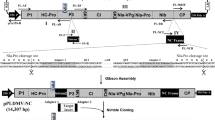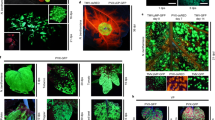Abstract
The region of whole Zea mays plants most susceptible to Agrobacterium–mediated transfer of infectious maize streak virus has been identified. Injection of a suspension of bacterial cells in meristematic tissues at or close to the apex gives a high proportion of plants showing viral symptoms, whereas inoculations in non–meri–stematic tissues give few or no symptomatic plants. We have developed a simple, reliable, sensitive and rapid assay for the transfer of DNA from Agrobacterium to plant, which allows a large number of independent inoculations to be screened.
This is a preview of subscription content, access via your institution
Access options
Subscribe to this journal
Receive 12 print issues and online access
$209.00 per year
only $17.42 per issue
Buy this article
- Purchase on Springer Link
- Instant access to full article PDF
Prices may be subject to local taxes which are calculated during checkout
Similar content being viewed by others
References
Gheysen, G., Dhaese, P., Van Montagu, M., and Schell, J. 1985. DNA flux across genetic barriers: the crown gall phenomenon, p. 11–47. In: Genetic Flux in Plants. Hohn, B., and Dennis, E. S., (Eds. ). Springer, New York and Vienna.
Fraley, R.T., Rogers, S.G., and Horsch, R.B. 1986. Genetic transformation in higher plants. CRC Critical Rev. in Plant Sci. 4:1–46.
Koukolíková-Nicola, Z., Albright, L., and Hohn, B. 1987. The mechanism of T-DNA transfer from Agrobacterium tumefaciens to the plant cell, p. 109–148. In: Plant DNA Infectious Agents. Hohn, T., and Schell, J. (Eds.). Springer, New York and Vienna.
De Cleene, M. 1985. The susceptibility of monocotyledons to Agrobacterium tumefaciens. Phytopath. Z. 113:81–89.
Hernalsteens, J.P., Thia-Toong, L., Schell, J., and Van Montagu, M. 1984. An Agrobacterium-transformed cell culture from the monocot Asparagus officinalis. EMBO J. 3:3039–3042.
Hooykaas-Van Slogteren, G.M.S., Hooykaas, P.J.J., and Schilperoort, R.A. 1984. Expression of Ti-plasmid genes in monocotyledonous plants infected with Agrobacterium tumefaciens. Nature 311:763–764.
Graves, A.C.F., and Goldman, S.L. 1986. The transformation of Zeamays seedlings with Agrobacterium tumefaciens. Plant molec. Biol. 7:43–50.
Graves, A.C.F., and Goldman, S.L. 1987. Agrobacterium tumefaciens-mediated transformation of the monocot genus Gladiolus: detection of expression of T-DNA encoded genes. J. Bacteriol. 169:1745–1746.
Schäfer, W., Görz, A., and Kahl, G. 1987. T-DNA integration and expression in a monocot crop plant after induction of Agrobacterium. Nature 327:529–532.
Bytebier, B., Deboeck, F., De Greve, H., Van Montagu, M., and Hernalsteens, J.-P. 1987. T-DNA organization in tumor cultures and transgenic plants of the monocotyledon Asparagus officinalis. Proc. Natl. Acad. Sci. U.S.A. 84:5345–5349.
Christou, P., Platt, S.G., and Ackerman, M.C. 1986. Opine synthesis in wild-type plant tissue. Plant Physiol. 82:218–221.
Grimsley, N.H., Hohn, B., Hohn, T., and Walden, R.M. 1986. Agroinfection, an alternative route for plant viral infection by using the Ti-plasmid. Proc. Natl. Acad. Sci. USA. 83:3282–3286.
Grimsley, N.H., and Bisaro, D. 1987. Agroinfection, p. 87–107. In: Plant DNA Infectious Agents. Hohn, T., and Schell, J. (Eds). Springer, New York and Vienna.
Grimsley, N.H., Hohn, T., Davies, J.W., and Hohn, B. 1987. Agrobacterium-mediated delivery of infectious maize streak virus into maize plants. Nature 325:177–179.
Hohn, B., Hohn, T., Boulton, M.I., Davies, J.W., and Grimsley, N.H. 1987. In: Plant Molecular Biology 1987. Von Wettstein, D. and Chua, N.-H. (Eds.). Plenum, New York.
Hoekema, A., Hirsch, P.R., Hooykaas, P.J.J., and Schilperoort, R.A. 1983. A binary plant vector strategy based on separation of the vir, and T-region of the Agrobacterium tumefaciens Ti-plasmid. Nature 303:179–181.
Zambryski, P., Joos, H., Leemans, J., Van Montagu, M., and Schell, J. 1983. Ti plasmid vector for the introduction of DNA into plant cells without alteration of their normal regeneration capacity. EMBO J. 2:2143–2150.
Baba, A., Hasezawa, S., and Syono, K. 1986. Cultivation of rice protoplasts and their transformation mediated by Agrobacterium spheroplasts. Plant Cell Physiol. 27:463–471.
Potrykus, I., Saul, M.W., Petruska, J., and Shillito, R.D. 1985. Direct gene transfer to cells of a graminaceous monocot. Molec. gen. Genet. 199:183–188.
Lörz, H., Baker, B., and Schell, J. 1985. Gene transfer to cereal cells mediated by protoplast transformation. Molec. gen. Genet. 199:178–182.
Fromm, M.E., Taylor, L.P., and Walbot 1986. Stable transformation of maize after gene transfer by electroporation. Nature 319:719–793.
Uchimiya, H., Fushimi, T., Hashimoto, H., Harada, H., Syono, K., and Sugawara, Y. 1986. Expression of a foreign gene in callus derived from DNA-treated protoplasts of rice (Oryza saliva L.) Molec. gen. Genet. 204:204–207.
Abdullah, R., Cocking, E.C., and Thompson, J.A. 1986. Efficient plant regeneration from rice protoplasts through somatic embryogen-esis. Bio/Technology 4:1087–1090.
Yamada, Y., Zhi-Qi, Y., and Ding-Tai, T. 1986. Plant regeneration from protoplast-derived callus of rice (Oryza saliva L.). Plant Cell Reports 5:85–88.
Kyozuka, J., Hayashi, Y., and Shimamoto, K. 1987. High frequency plant regeneration from rice protoplasts by novel nurse culture methods. Molec. gen. Genet. 206:408–413.
De la Peña, A., Lörz, H., and Schell, J. 1987. Transgenic rye plants obtained by injecting DNA into young floral tillers. Nature 325:274–276.
Davies, J.W., Townsend, R., and Stanley, J. 1987. The structure, expression, functions and possible exploitation of geminivirus genomes, p. 31–52. In: Plant DNA Infectious Agents. Hohn, T., and Schell, J. (Eds.). Springer, New York and Vienna.
Maniatis, T., Fritsch, E.F., and Sambrook, J. 1982. Molecular Cloning. A Laboratory Manual. Cold Spring Harbor Laboratory Press, N. Y.
Holsters, M., Silva, B., Van Vliet, F. et al. 1980. The functional organization of the nopaline A. tumefaciens plasmid. Plasmid 3:212–230.
Rogers, S.G., Horsch, R.B., and Fraley, R.T. 1986. Gene transfer in plants: Production of transformed plants using Ti-plasmid vectors. Meth. Enzymol. 118:627–640.
Sass, J.E. 1958. Botanical Microtechnique, p 14–54. The Iowa State University Press, Ames, Iowa.
Author information
Authors and Affiliations
Rights and permissions
About this article
Cite this article
Grimsley, N., Ramos, C., Hein, T. et al. Meristematic Tissues of Maize Plants Are Most Susceptible to Agroinfection With Maize Streak Virus. Nat Biotechnol 6, 185–189 (1988). https://doi.org/10.1038/nbt0288-185
Received:
Accepted:
Issue Date:
DOI: https://doi.org/10.1038/nbt0288-185
This article is cited by
-
Further characterization of Maize chlorotic mottle virus and its synergistic interaction with Sugarcane mosaic virus in maize
Scientific Reports (2017)
-
Problems and possibilities of monocot transformation
Biologia plantarum (2011)
-
Limitations observed in the use of agroinoculation for geminivirus research
Virus Genes (2008)



